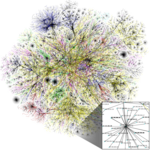
Back ديمقراطية إلكترونية Arabic E-demokratiya Azerbaijani Электронная дэмакратыя Byelorussian Электронная дэмакратыя BE-X-OLD Democràcia electrònica Catalan E-demokracie Czech E-Demokratie German Interreta rekta demokratio Esperanto Democracia digital Spanish E-demokraatia Estonian
| Part of the Politics series |
| Politics |
|---|
|
|
| Part of the Politics series |
| Democracy |
|---|
|
|
| Internet |
|---|
 |
|
|
| Part of the Politics series |
| Basic forms of government |
|---|
| List of countries by system of government |
|
|
E-democracy (a blend of the terms electronic and democracy), also known as digital democracy or Internet democracy, uses information and communication technology (ICT) in political and governance processes.[1][2] The term is credited to digital activist Steven Clift.[3][4][5] By using 21st-century ICT, e-democracy seeks to enhance democracy, including aspects like civic technology and E-government. Proponents argue that by promoting transparency in decision-making processes, e-democracy can empower all citizens to observe and understand the proceedings. Also, if they possess overlooked data, perspectives, or opinions, they can contribute meaningfully. This contribution extends beyond mere informal disconnected debate; it facilitates citizen engagement in the proposal, development, and actual creation of a country's laws. In this way, e-democracy has the potential to incorporate crowdsourced analysis more directly into the policy-making process.[6]
Electronic democracy incorporates a diverse range of tools that use both existing and emerging information sources. These tools provide a platform for the public to express their concerns, interests, and perspectives, and to contribute evidence that may influence decision-making processes at the community, national, or global level. E-democracy leverages both traditional broadcast technologies such as television and radio, as well as newer interactive internet-enabled devices and applications, including polling systems. These emerging technologies have become popular means of public participation, allowing a broad range of stakeholders to access information and contribute directly via the internet. Moreover, large groups can offer real-time input at public meetings using electronic polling devices.[7]
Utilizing information and communication technology (ICT), e-democracy bolsters political self-determination. It collects social, economic, and cultural data to enhance democratic engagement.
As a concept that encompasses various applications within differing democratic structures, e-democracy has substantial impacts on political norms and public engagement. It emerges from theoretical explorations of democracy and practical initiatives to address societal challenges through technology. The extent and manner of its implementation often depend on the specific form of democracy adopted by a society, thus shaped by both internal dynamics and external technological developments.
When designed to present both supporting and opposing evidence and arguments for each issue, apply conflict resolution and Cost–benefit analysis techniques, and actively address confirmation bias and other cognitive biases, E-Democracy could potentially foster a more informed citizenry. However, the development of such a system poses significant challenges. These include designing sophisticated platforms to achieve these aims, navigating the dynamics of populism while acknowledging that not everyone has the time or resources for full-time policy analysis and debate, promoting inclusive participation, and addressing cybersecurity and privacy concerns. Despite these hurdles, some envision e-democracy as a potential facilitator of more participatory governance, a countermeasure to excessive partisan dogmatism, a problem-solving tool, a means for evaluating the validity of pro/con arguments, and a method for balancing power distribution within society.
Throughout history, social movements have adapted to use the prevailing technologies as part of their civic engagement and social change efforts. This trend persists in the digital era, illustrating how technology shapes democratic processes. As technology evolves, it inevitably impacts all aspects of society, including governmental operations. This ongoing technological advancement brings new opportunities for public participation and policy-making while presenting challenges such as cybersecurity threats, issues related to the digital divide, and privacy concerns. Society is actively grappling with these complexities, striving to balance leveraging technology for democratic enhancement and managing its associated risks.
- ^ Noveck, Beth Simone (2017). "Five hacks for digital democracy". Nature. 544 (7650): 287–289. Bibcode:2017Natur.544..287N. doi:10.1038/544287a. PMID 28426018.
- ^ Ann Macintosh (2004). "Characterizing E-Participation in Policy-Making" (PDF). 2004 International Conference on System Sciences. Archived from the original (PDF) on 19 August 2019. Retrieved 15 December 2014.
- ^ Azyan, Liz (3 August 2009). "Liz talks to Steven Clift from e-democracy.org at the Personal Democracy Forum Conference 09". Liz Azyan. Archived from the original on 25 October 2020. Retrieved 20 November 2020.
- ^ "Challenge and promise of e-democracy". Griffith Review. Archived from the original on 25 January 2021. Retrieved 21 November 2020.
- ^ "politics". Archived from the original on 17 May 2021. Retrieved 21 November 2020.
- ^ Hosein Jafarkarimi; Alex Sim; Robab Saadatdoost; Jee Mei Hee (January 2014). "The Impact of ICT on Reinforcing Citizens' Role in Government Decision Making" (PDF). International Journal of Emerging Technology and Advanced Engineering. Archived (PDF) from the original on 17 April 2016. Retrieved 15 December 2014.
- ^ "Public Participation Guide: Electronic Democracy". U.S. Environmental Protection Agency. 18 March 2014. Retrieved 17 May 2023.
 This article incorporates text from this source, which is in the public domain.
This article incorporates text from this source, which is in the public domain.